Lynn Hill
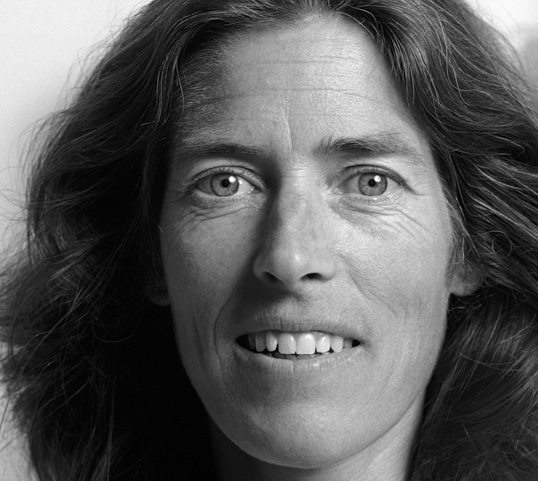
 1 / 8
1 / 8 Giulio Malfer
Giulio Malfer
Seven years have passed since your one-day ascent of the Nose, and it’s still something people talk about. Perhaps even more now than ever before...
It was something so new at the time, many probably didn’t realise what had happened. At the time all the pitches on the Nose, except for the Great Roof, had been freed, but no one had managed to link the entire route. What is more, many believed - and I’m talking about people extremely competent such as Jim Bridwell – that this project was impossible. What I mean is that not only was it impossible that a women could it, it was simply unthinkable that it could be done at all. No one said “The Nose free? Go on, you’ll do it”, repeating the joke, in vogue in the Valley at the time, that convinces you to attempt a guaranteed fiasco. Everyone agreed that it was simply “Impossible!”. Fullstop.
How did you prepare for the “impossible” Nose?
First and foremost I believed in myself. Then I trained... a lot! Five months just for the first free ascent in less than 24 hours. The training was both physical and mental. I ran, climbed, worked-out... but above all I concentrated on the mental aspect, how to approach the climb from a psychological point of view. The motivation, style and ascent were the result of this intense preparation. And this subsequently underlined my conviction that climbing isn’t simply about reaching the summit, but rather everything that revolves around it. The way you reach the summit. This means living each moment enthusiastically, on the path that leads towards the goal.
What about nutrition, integrators etc?
This forms part of my own personal philosophy: I don’t use food supplements, amino acids etc. I believe that while their physiological effects are practically irrelevant, their psychological effect can be immense. To improve I start from a different premise. I ask myself: Why can’t my approach to climbing be more intelligent? How can I focus my energy more efficiently? The idea (and the answer) is that we need to adapt ourselves to the rock, and not the opposite.
With what spirit did you climb the 33 pitches in those 23 hours?
As much as possible I tried to be at one with the rock and my body. Dosing my energy, finding just the right amount necessary for every move. My motto was: be patient and relaxed, always!. No rush, no anger, because I feel these don’t belong in climbing, or at least not in mine. I looked for a “lightness” of being, in everything. A completely smooth ascent, fluid, being at one with the wall. Moves in total harmony, searching for the right rhythm, excluding all thoughts that had nothing to do with the climb. I saw it as the search for the perfect climbing state of mind...
How demanding was the ascent and what did it give you?
In 20 years of climbing I had never made such a great and complete effort to accomplish something. The experience was complex and all embracing; above all it gave me an insight into myself. Apart from the satisfaction at having achieved something – which was obviously very great indeed – it motivated me to believe in our own will, in the possibilities that we all have in reaching our limits and going one step further. Obviously it also made me extremely happy: climbing routes such as the Nose, climbing big walls free, is what I love most.
A love that started when you were 14 years old, in California….
Yes. I started climbing with my elder sister in 1975, on granite. I immediately enjoyed it and discovered that it was my sport. I had done gymnastics at High School and having this background was a great help. I continued climbing and, on seeing my achievements, was immediately accepted as part of the scene, and in many respects I was a tomboy. Yosemite Valley’s granite and above all John Long did the rest. The Yosemite experience was fundamental for my adventure on the Nose and for the way in which I continue to interpret this sport.
In 1985 you started you long European tour, to the South of France and Italy, in search of limestone crags...
I love travelling; it’s an important aspect of my life. I need to experience new sensations and meet new people to find my inner balance. And in the South of France, but also in Italy, I felt extremely at ease. So the experience I gathered, and continue to gather, was fundamental and I feel profoundly linked to these lands. I feel at ease with the people here, but then of course there’s also the climbing: Verdon, Ceuse, Cinque Torri, Arco... an infinite number of great crags and opportunities. With fantastic limestone that, having climbed on granite previously, was a great and completely new experience.
Then you appeared on the competition scene and immediately made a name for yourself. What did all this give you?
I think that competitions are a great thing, especially for young climbers. Without a doubt they are something positive. The competition circuit gives you the chance to get to know other realities, on an international level, to experience great things. Competitions help you prepare yourself; you learn to give your best at exactly the right moment. This is certainly another aspect that helped me for my ascent of the Nose. I feel that that competing, wanting to win, reaching the top are all things that are inborn, but at times it’s important to take a step forward, mature, and examine life from a different angle.
Is this why you stopped competing in 1992?
I have to say that stopping competing gave me a new sense of freedom. When I took the decision to stop, the competition environment was slowly beginning to change: the more competitions took off, the less fun it all became. Feeling part of a group, travelling with close friends, enjoying life climbing, wanting to be there with the others… these were all aspects that had characterised the start of my climbing career but which I now began to miss. Instead I saw more and more people with bulimia, anorexia… It seemed as if this friendship, the initial group spirit had disappeared.
Right when you wanted to confront yourself on competition routes set for men.
Yes, this is true. In 1989 in Lyon both Luisa Iovane and I – after our joint-equal in the Final – wanted to compete on the men’s route for the Super-final. We wanted to confront ourselves on equal terms with men. And the crowd wanted it too. I had wanted to climb on the men’s route right from the outset, but in reality I knew that both the climbing walls and the route setters’ experience and capabilities weren’t yet sufficiently developed to overcome the morphological differences, such as height, that play in men’s favour.
Such as on The Nose where, according to some, you were at an advantage due to your small fingers.
It’s true that on The Great Roof my fingers fit better, but this doesn’t mean that it’s impossible for someone bigger than me. On the other hand, there are some sections on the 900m route where, compared to taller climbers, I was disadvantaged. A long reach helps enormously at the start of the corner, which for me is the crux of the entire route.
Have there been other big wall ascents that impressed you?
What Yuji Hirayama did on the Salathe was absolutely spectacular, and I regard it as one of the best performances of this sort. His ascent was truly courageous; announcing beforehand that he wanted to attempt it on-sight made it all the more difficult. It’s one thing fixing a personal target, but it’s something completely different if you invite all to come and watch. Obviously it’s fantastic for the spectator, but for the actor everything automatically becomes much more complicated.
Who will manage to repeat the Nose in less than 24 hours?
Leo Houlding told me he intended to try it. His approach to climbing is uninhibited, he doesn’t worry about much, he likes something and so he goes out and tries it, no matter what the outcome. I’d be really happy if he managed to do it because I like Leo, he has a way of climbing that in many ways is similar to mine.
And what about Scott Birch’s free ascent of the Nose…
What can I say? 261 days to climb all the pitches free… I respect his determination. The route was really hard for him and therefore a great result. Then again, it’s all a game!
In recent years you dabbled in mountaineering.
Yes, my first mountaineering expedition was to Kyrgyzstan. Together with Conrad Anker and Dan Osman we climbed a route alpine style. But snow isn’t really my element – I love climbing on rock much more and I’m interested in “performing” there, rather than at altitude.
Do you prefer to travel and climb in far away places such as Vietman or Madagascar?
Certainly, even though it’s an enormous effort. In Vietnam we made some first ascents on completely untouched faces in beautiful areas. Cleaning the wall and placing the bolts was really hard work. Madagascar was a very particular experience: our expedition was comprised of women only, and here too we had to work hard to make the first ascent.
Future projects, perhaps another big wall ascent like the Nose?
In November I’m off to Cuba. Then I’d like to try El Nino on El Cap… I really like climbing new routes!
How do you choose your projects and what would you recommend?
First and foremost my projects must be motivated by personal targets. Then I ask myself: “Is it possible? What advantages do I draw from this?” To give you an example, in bouldering – which I consider the essence of climbing – my height is a distinct disadvantage, at times I can’t even reach the first hold. But (she adds with a smile – editor’s note) the grade is not important; the experience must be significant. This is the advice I’d like to give.
LYNN & THE NOSE
da ALP Grandi Montagne - Yosemite
by Vinicio Stefanello
Can you evoke an ascent from a route sketch? We try to do just this with Lynn Hill, to retrace her mythical free ascent of the Nose. Following the lines on a sheet of paper we relive her adventure on the immense Cap spire that lasted less than 24 hours.
"The Nose has it all: slabs, overhangs, cracks". And halfway up the 2nd pitch Lynn encounters the first test: "Two difficult moves to reach the ledge and then relax, climbing the cracks on the 4th and 5th pitch.” Each crack is unique. Such as “the Stovelegs Crack system, on the 9th pitch, where you start with hand jams and then finish with fist jams". Like the short and wide 11th pitch: "lieback or jams, whichever you choose, it’s always a strange pitch”. And so Lynn climbs on, past the Dolt Tower to reach the Jardine Traverse. Keep left here for the free ascent: "It’s difficult, especially at the start where some footholds and a fundamental handhold have been improved. They could have done without these, but it would have been even harder.”
The race continues to the left of Texas Flake up an interesting crack: "it changes in size throughout, from finger jams to fist jams... I liebacked." Fast. On the 18th pitch there’s the small roof which “wasn’t too difficult to climb free.” And so on to Camp IV: "Watch out! If someone is bivying above, you’re right in gravity’s path.” And Lynn too was hit: “It brought me luck: I freed the Great Roof.” Or rather, the 22nd pitch, one of the crux sections on the Nose. “The Great Roof is very long. The curve that leads to the traverse beneath the Roof is extremely delicate and slippery.” Carefully dosed moves and perfect balance along an incredible series of upside-down two-finger pockets: “Hard and spectacular.”
The door to the splendid Pancake Flake is now open: "This is one of the most beautiful sections on the Nose, up a spectacular technical crack. The rock is outstanding and from here you can see the entire route beneath you; you’re suspended between what you’ve just climbed and what still lies ahead!” Pitches 23, 24, 25; Lynn fights up a narrow chimney, bridges wide and liebacks the corner crack, (placing natural pro as she goes) to reach the large Camp IV ledge. From here the free version follows the original line. Not the Brooke’s variation but: “you continue up strange but beautiful moves along the corner used during the first ascent.” Another nice crack to reach the 30th pitch, a.k.a. Death block, where the wedged block is no longer in place: “ A friend of mine got rid of it last year... only a couple of slings still held it in place!”
Almost there! The enormous corner is now followed by the final section. And for a second Lynn almost blows it completely: “On the difficult overhang I lose my feet, while holding a small flake and an edge with just two fingers: foot quickly up high onto the “jug”, stand up, without my left hand. That was close!” After a difficult bulge she reaches the last belay, only a stone’s throw from the top. Final act: one hard move and it’s all over! Quick look at the clock: 23 hours. This all happened 8 years ago and, as yet, no one has equalled this ascent.
Born in Detroit in 1961, Lynn grew up in California. After swimming and gymnastics she started climbing at the age of 13. Joshua Tree and Yosemite Valley were her initial testing grounds, before discovering Europe's limestone.
During her competition career she won the coveted Rock Master 5 times, the World Cup in 1989 and numerous other international competitions.
In 1993 she completed the first free ascent of the Nose on El Capitan, Yosemite. In 1994 afterwards she repeated this feat, climbing all pitches free in just 23 hours.
The Nose
"My motto was: be patient and relaxed, always!. No rush, no anger, because I feel these don’t belong in climbing, or at least not in mine. I looked for a “lightness” of being, in everything. A completely smooth ascent, fluid, being at one with the wall. Moves in total harmony, searching for the right rhythm, excluding all thoughts that had nothing to do with the climb. I saw it as the search for the perfect climbing state of mind..."
The Nose
FA: W. Harding, W. Merry, G. Whitmore - 1958
Length: 870 m (31 pitches)
Grade.: 5.13c or 5.9 A2
FFA: Lynn Hill '93
This is the route, it marked the era of big wall climbing in Yosemite. A true work of art; audacity and tenacity enabled the first ascentionists to invent and believe in this completely direct line up El Cap.



 Copia link
Copia link

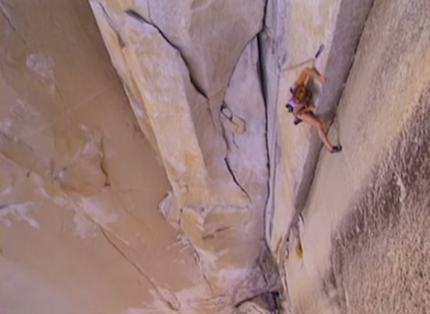
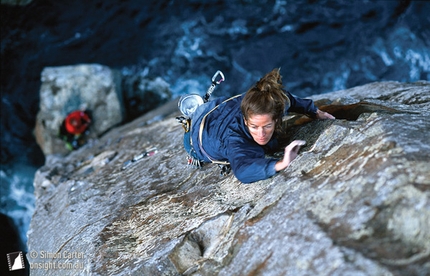

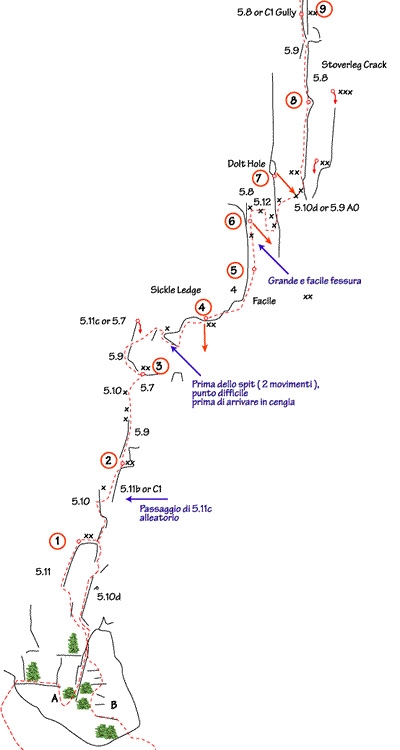
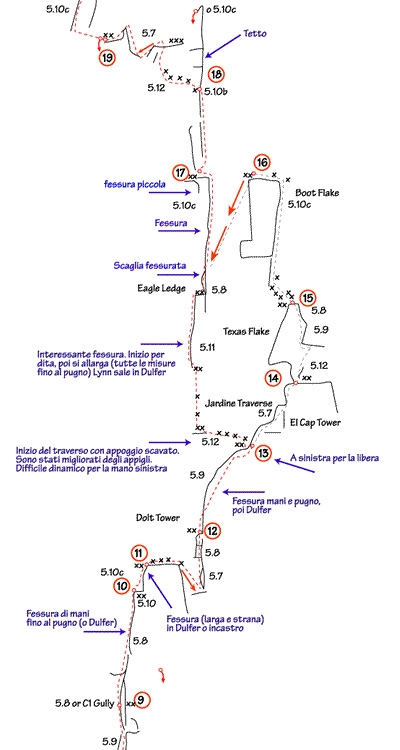
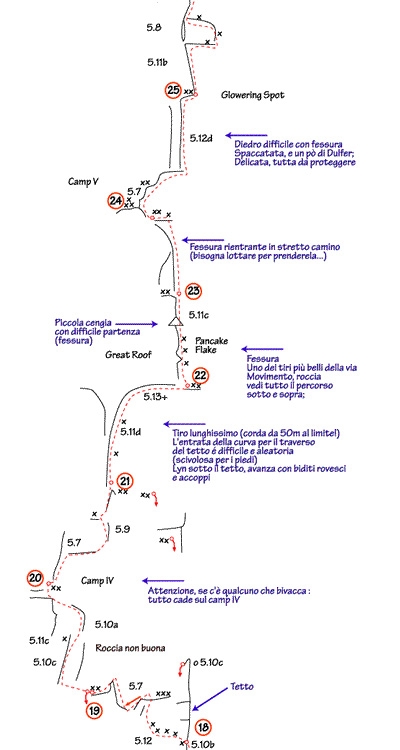
 See all photos
See all photos






















